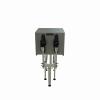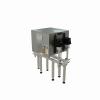The GLOBALTEK® stainless steel construction heat tunnel is manufactured to meet highest standards for the pharmaceutical, food/beverage and many more industries. Our heat tunnel is precisely designed to ‘heat shrink’ shrinkable film wrapped around your package and it is also suitable to shrink a shrinkable neck band or body sleeve around a container.
Bottles must be transported through the heat tunnel with a compatible conveyor (not included) at a consistent and applicable speed. Our heat tunnel includes four Hapco Bak hot air blowers with 360° wide slot adjustable nozzles to ensure the perfect fit for your products' height and depth needs. The stainless steel double wall heating chamber is enclosed by tight-seal brush bristles and a silicone coated fiberglass heat trapping curtain to ensure an even and consistent shrink rate. The double wall ensures the exterior surface area does not overheat.
SPECIFICATIONS:
- Four Hapco Bak hot air blowers (230V, 3700W) with 360° wide slot adjustable nozzles to ensure the perfect fit for your products’ height and depth needs.
- Variable temperature and air-flow settings.
- Suitable for shrinkage of sleeve labels made of different materials and thickness (from 35 to 60 microns).
- Suitable for containers up to 10” diameter x 19” tall.
- Mounts to any existing conveyor with a stainless steel belt or high temperature belt. *Conveyor not included.
- Electrical Requirement: 230V single phase 60 Hz
- Overall machine dimensions: 36” x 26” x 22”
***Conveyor not included***
(if needed, please let us know your desired length and width as we have many sizes available in stock)
Benefits of a Heat Shrink Tunnel
-
Consistent, 360° shrink: Adjustable hot-air nozzles apply uniform heat for smooth sleeves and bands.
-
Clean appearance & tamper evidence: Tight, wrinkle-free results improve shelf presence and provide visible product security.
-
Wide material compatibility: Handles common sleeve films (e.g., PETG, PVC, OPS) across multiple gauges.
-
Fast changeovers: Tool-less nozzle adjustments and recipe presets reduce downtime between SKUs.
-
Compact integration: Mounts over existing conveyors to fit new or retrofit packaging lines.
How to Choose Film Gauge and Speed Settings
Film gauge (typical ranges):
-
Neck bands: 35–45 µm (lower gauge conforms quickly, minimizes material use).
-
Body sleeves (straight walls): 40–50 µm for balanced stability and shrinkage.
-
Contoured or tall containers: 50–60 µm to resist tearing over complex geometries.
Material notes:
-
PETG: High shrink ratio and clarity; use moderate air temp with controlled airflow to avoid “blowouts.”
-
PVC: Shrinks at lower temps; good for neck bands; monitor for haze if overheated.
-
OPS: Good stability; needs even heat and slightly longer dwell.
Line setup workflow:
-
Start with recipe: Select film type/gauge and container height; load the closest saved profile.
-
Set dwell time via conveyor speed: Begin slower (longer dwell), then increase speed until shrink is smooth with no distortion.
Balance temperature & airflow: Raise the temperature to improve shrink; raise the airflow to tighten around contours. Adjust one variable at a time.
-
Tune nozzles: Aim 360° slots at label high-shrink zones (shoulders, base).
-
Validate: Check seams, perforations, and tamper bands; confirm no scuffing or label creep after cooling.
Quick targets (starting points; fine-tune on product):
-
Neck bands: short dwell, lower temp, focused airflow at the band.
-
Full sleeves: moderate dwell, balanced temp/airflow, with extra attention at shoulder/base transitions.
Maintenance Tips for Hot-Air Tunnels
Daily
-
Inspect nozzle slots for debris; wipe exterior surfaces after cool-down.
-
Verify curtains/brush seals are intact and seated to maintain chamber efficiency.
-
Confirm airflow and temperature readings match the recipe; test E-stop.
Weekly
-
Check fasteners, clamps, and ducting; tighten if needed.
-
Inspect conveyor clearance and bottle guides for rub points.
-
Clean inlet screens on blowers; confirm smooth nozzle adjustment.
Monthly
-
Inspect wiring and connectors for heat fatigue; verify strain reliefs.
-
Check blower bearings per manufacturer guidance; listen for noise/vibration.
-
Review and back up HMI/PLC recipes; document any parameter changes.
Safety Guidelines and Troubleshooting
Safety
-
Hot surfaces: Allow full cool-down before service; use heat-rated gloves and sleeves.
-
Lockout/Tagout: De-energize before opening panels or removing guards.
-
Airflow caution: Keep hands, film tails, and loose clothing away from nozzle outlets.
-
Ventilation: Operate in a well-ventilated area; follow facility heat-load guidelines.
Troubleshooting (common issues)
-
Wrinkles / “orange peel”: Air temp too low or dwell too short → increase dwell (slow conveyor) or raise temp incrementally.
-
Fish-eyes / voids: Airflow too strong or film overheated → reduce airflow or lower temp; re-aim nozzles away from thin sections.
-
Label creep / rotation: Excessive airflow or bottle instability → reduce airflow; improve container guides or spacing.
-
Tearing at shoulders / base: Gauge too light or heat too concentrated → step up film gauge or diffuse nozzle focus; lower temp slightly.
-
Incomplete shrink at bottom edge: Dwell too short or nozzle misaligned → slow conveyor; angle lower nozzles toward the base.
-
Haze / gloss loss (PVC): Overheating → reduce temp and/or dwell; verify balanced airflow.
Frequently Asked Questions
No posts found









